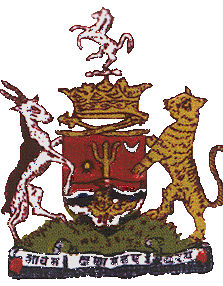MORVI

BRIEF HISTORY
Allyaji, the second son of Kanyoji, succeeded his father in 1734. He lost Malia to his younger brother Modji, after the latter had encouraged large numbers of the refractory Miana tribe to settle in his jagir and assist him in his rebellion. Rawaji, extended his domains by conquering several villages from the Jam Sahib of Nawanagar. He fortified Morvi, constructed a number of buildings, extended and beautified the town. His death in 1764 was followed by a sixty year period of almost continuous warfare and rebellion, mostly with Cutch or its allies. The restoration of peace had to wait until the assumption of British rule during the early years of the nineteenth century. However, a final settlement could not be effected until the late 1820's.
With the establishment of peaceful relations with all his neighbours, Thakore Ravaji II, who succeeded in 1846, could concentrate on reorganising the administration, reform the judicial system and improve the revenues of the state. He enjoyed the first peaceful reign in five generations.
Maharaja Waghji succeeded his father as a minor in 1870. The state was placed under administration and he was sent to school at the new princes' college at Rajkot. Emerging from his minority he took charge of his state in 1879 and immediately set about developing it. A gifted administrator who modernised his state, introduced the first telephonic communications, a system of district tramways, built roads, schools and reservoirs, improved the city with bridges, public buildings and amenities, and banned money lenders in favour of state loans. He improved the old port of Vavania, enabling it to take ocean-going vessels, and constructed a modern industrial port at Naulakha. Both helped to stimulate trade, especially the local textile and salt industries. His tireless efforts were rewarded were recognised when Morvi was raised to the status of a first class state in 1887. The Thakore Sahib reigned for fifty-two years and died in 1922.
Maharaj Lakhdhirji was just as progressive and energetic as his illustrious father, but was not entirely sympathetic with the nationalist aspirations emerging around him. He did much to beautify his capital and other towns with fine public buildings, bridges, and palaces but forbade newspapers and resisted any sort of democratic reforms. Although he dutifully signed the instrument of accession to the Dominion of India in 1947, he abdicated in favour of his eldest surviving son and heir within a year. It was left to Maharaja Mahendrasinhji, who had assisted his father in the administration for several years, to oversee the final transfer of the state and its merger into the Kathiawar Union. A gifted sportsman who was much addicted to the turf, in later life. He retired from public life and died at his English country home, Buckhurst Park, in Ascot, within three months of his father.
Maharaja Mayurdhwaj succeeded his father in 1957, and enjoyed his titular ranks and titles until the revocation of those rights by Mrs Gandhi's government in 1971. He died unmarried and without a male heir, seven years later.
CLAN:
Jadeja clan of Rajputs.
SALUTE:
11-Guns
ARMS:
Wavy stripes of azure and argent, with an eastern gallion under sail and flying a pendant proper. In the centre a trident or, between a sun in splendour of fourteen rays (dexter) and a crescent argent (sinister). Above the shield crossed swords (points downward) proper crowned by a crown or.Crest: A horse rampant argent. Supporters: Antelope and tiger proper.
FLAG:
A rectangular flag of seven equal stripes, violet, indigo, blue, green, yellow, saffron and red (top to bottom) with crossed swords (points upwards) "MS" between the hilts and the crest, a white horse with a wreath over the top.
STYLES & TITLES:
The ruling prince: Maharaja Thakore Shri (personalname) Sahib Bahadur, Maharaja of Morvi, with the style of His Highness.
The consort of the ruling prince: Maharani Shri (personalname) Sahiba, Maharani of Morvi, with the style ofHer Highness.
The Heir Apparent (when an only son): Maharajkumar Shri (personal name) (father's name) Sahib.
The Heir Apparent (when an eldest son): Yuvraj Shri (personal name) (father's name) Sahib.
The daughters of the ruling prince: Maharajkumari Bai Shri (personalname) Sahib.
The grandsons and great-grandsons of the ruling prince, in the male line: Kumar Shri (personal name) (father's personal name).
The grand-daughters of the ruling prince, in the male line: Rajkumari Bai Shri (personal name) Sahib.
ORDERS & DECORATIONS:
None.
RULES OF SUCCESSION:
Male primogeniture, with the right of adoption by the recognised head of the family on the failure of natural male heirs.
SOURCES:
Lewis Bentham Bowring, Bowring Collection. MSS. Eur. G.38, Oriental India Office Collection, British Library, London..
SPECIAL ACKNOWLEDGEMENTS:
Dr. Morris Bierbrier, FSA.